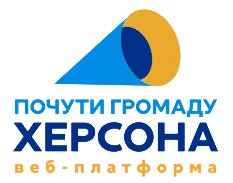Methodology: An online survey using an interactive structured questionnaire; links to the survey were sent to potential respondents from the database (online research panel of the Kherson community). The sample was based on demographic indicators as of January 1, 2022. Given the indicators, the research margin of error does not exceed 5%, with a probability of 0.95. The sample included Kherson residents both currently residing within the community and those who left Kherson after February 24, 2022 to other regions of Ukraine or abroad. Currently, there is no official data on the migration of Kherson’s residents, thus making it impossible to assess the given respondent sample’s representativity. However, there are reasons to believe that the ratio of those reporting themselves still residing within the community presented is greater than the actual ratio, which may affect the research results.
Research objective: to find out the nature and dynamics of the Kherson residents’ unity in wartime.
Sample scope: 400 respondents.
Field stage period: September 20 – 30, 2024.
Research client: Community Foundation of Kherson “Zakhyst”.
Key Findings
1.Interviewed Kherson residents mostly believe that “50-50” best describes the unity of the Kherson community. The
percentage of those who believe unity exists between Kherson residents is higher than that of those who think the opposite – 32% to 23%. Moreover, those who have stayed in Kherson have a lower sense of unity (26% in total) than those residing outside the community (43%). Respondents also believe that since the start of the full-scale war, community cohesion has increased by 7% compared to the period before February 24, 2022.
2.Middle-aged people (36-60) and older Kherson residents are the most united. According to respondents, gender and age are significantly contributing factors to community unity.

3.The top three main indicators of unity are continuous support (noted by 69% of respondents), participation in volunteer activities (57%), and protest campaigns (56%).
4.Participation in volunteering and protest campaigns in 2022 likely increased the assessment of community unity as compared to before Russia’s full-scale invasion, when the main activities of interest for Kherson residents were celebrations of city holidays (71%) and participation in cultural events (49%).
5.Residents themselves at the level of grassroots initiatives (72%), volunteers (57%), and social media (56%), while the Kherson City Military Administration (51%) and again the residents themselves (25%) hinder it, according to the
respondents.
6.There are certain factors hindering community unity, the most notable being distrust of authorities (72%), lack of understanding of the city’s development strategy (55%), the see no evil, hear no evil mentality (46%), and lack of leaders (45%).

You can read the full report by downloading it or read it in Ukrainian.
This research was conducted by the Zakhyst Kherson Community Foundation Charitable Organization as a part of its project implemented under the USAID/ENGAGE activity, which is funded by the United States Agency for International Development (USAID) and implemented by Pact. The consents of this research are the sole responsibility of Pact and its implementing partners and do not necessary reflect the views of USAID or the United States Government/
Reproducing and using any part of this product in any format, including graphic and electronic, copying or any other usage is suitable to reference to the sourc/




